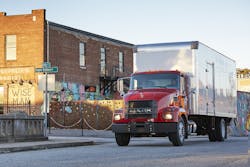There has been a booming trend toward last-mile delivery, and fleets are looking to a handful of vehicle types to provide such services, primarily step vans and medium-duty trucks. Most of these vehicles are well known by maintenance providers, with electric vehicles being the exception. But now that they are running more often, fleets must account for the dangers lurking in every corner of the concrete jungle.
For that reason, fleets with urban routes may need to re-evaluate their preventive maintenance strategy.
“These fleets have more stop-and-go driving and increased idle time,” said Meena Narahari, director of total cost of ownership and uptime at Navistar, which makes International trucks. “Delivery fleets also deal with higher levels of traffic congestion and can create more risk with weather-related incidents. Drivers have to be more attentive to avoid accidents and costly collisions. In this way, technology is critical in helping customers be more efficient with last-mile delivery.”
For instance, Navistar recently launched a partnership with Nauto, a predictive vehicle safety company that uses artificial intelligence and camera technology to provide in-vehicle alerts that help prevent collisions and encourage safer driving. “This kind of technology is inexpensive to install and has a compelling ROI for fleets,” Narahari said.
Densely populated areas are also thin on open space. “Urban routes can mean narrow streets, tight corners, and unexpected obstacles,” said Dayle Wetherell, VP of medium-duty sales at Mack Trucks, which re-entered the Classes 6-7 markets in 2020 with the Mack MD Series.
Looking to tire maintenance here will go a long way. “Correct tire inflation will help ensure better vehicle control while also increasing tire life,” Wetherell said.
But safer driving is just one piece of the profitability puzzle on an urban route. Fleet maintenance teams must also remain on heightened alert for malfunctioning vehicle systems and excessive wear caused by the unique rigors of urban environments.
Make high wear a high priority
One way to keep last-mile commercial vehicles going is by stocking an ample inventory of high-wear items and being ready to replace them ahead of schedule.
“Typical items to keep a regular eye on are brakes, tires, fluid levels, liftgates, reefer units, and mirrors,” explained Brian Tabel, executive director of marketing at Isuzu Commercial Trucks of America. “Look at the time a vehicle is being used along with the mileage. You may have to move up the maintenance based on time.”
That is because a last-mile delivery vehicle is placed under a lot of stress in a relatively short amount of time. It’s all about the duty cycle.
“The first thing a technician should think about is mileage accumulation,” said Dave Sowers, head of marketing at Ram Commercial Trucks. “Last-mile delivery vehicles will rack up mileage pretty quickly, but not nearly as quickly as an OTR truck. Technicians shouldn’t let that lower mileage fool them.
“What’s important to realize is that within that mileage accumulation is the cycling that happens,” Sowers continued. “The wear and tear per mile is much higher on a city delivery vehicle.”
It’s also important to note the rigors of urban delivery will affect parts differently.
“While some of the components on these vehicles suffer less wear than under normal conditions, such as transmissions and differentials, other components [face] three and four times the wear, such as tires and brakes,” said Terry Rivers, VP of maintenance and technical training at Cox Automotive Mobility Fleet Services, which represents the unification of Cox Automotive’s Dickinson Fleet Services and Interstate Truck Center brands.
“An eight-year-old vehicle with 70,000 miles might have 5,000 engine hours on it, which would be equivalent to roughly a quarter million miles under a different drive cycle,” Rivers said. “Thus, the severe-duty-cycle maintenance schedule is required. In my 40-plus years of experience in this industry, the severe-duty-cycle schedule is rarely adhered to.”
Rivers pointed out that the severe-duty maintenance schedules developed by the OEs have been developed for a reason.
“The wear and tear on brake components is excessive with all of that stop-and-go,” Rivers said. “The transmission rarely gets out of second gear, while the rest of the transmission remains in like-new condition. Thus, regular transmission maintenance is required. But additionally, the constant acceleration and deceleration cause excessive exhaust back pressure and crankcase pressure, which can contaminate the fresh air intake components.”
A technician must keep a vigilant eye on all of those maintenance items. Tire tread is another one. “Slow-speed traffic and frequent turning can lead to tread being scrubbed off on the road like cheese on a grater,” Rivers explained. “This is one of the top four pain points of fleets. Every scenario is unique, with road surfaces and temperatures playing a role in tire wear, which is why mileage isn’t always the best indicator.”Body operation can take a beating
The number of daily stops on a last-mile route, according to Ram Commercial’s Sowers, is generally in the 150 to 200 range. “That doesn’t include the stop-and-go traffic the vehicle also needs to contend with,” he pointed out. “Those are physical stops at a home or business. That’s where a lot of the wear comes into play.”
Drivers going in and out of a vehicle that many times can impact several things the typical heavy-duty technician isn’t used to, at least not those who normally service OTR vehicles. Fleet technicians should also recognize that delivery drivers are under a lot of pressure to improve cycle times and often work in a hurried fashion. For instance, it’s not uncommon for a driver to shift a vehicle into park while it’s still rolling. Similarly, it’s not unusual to leave the sliding door open while completing several adjacent stops.
“Doors, hinges, and latches get cycle times that are unbelievable in this type of application, so the technician really has to pay attention to them,” Sowers emphasized. “It may simply be a matter of lubing them, which is something technicians did all the time back in the 1960s. Then things like plastics came along which alleviated some of those needs. But now that we’re seeing these high-use cases again with final-mile, technicians need to start paying attention again. A door that won’t latch properly on a delivery vehicle is a vehicle-down situation just like a blown transmission.”
Malfunctioning lighting is also important. With the growth in last-mile delivery, drivers often find themselves operating in the dark. As Sowers pointed out, technicians won’t necessarily see more wear and tear on these systems, but ensuring proper function is more important than ever—and that includes interior lighting.
“On our Ram ProMaster van, for instance, we run LED lighting with motion detectors,” Sowers said. “This benefits the time-conscious driver who doesn’t have to worry about flipping switches on and off. But it also creates a lot of demand for electrical energy which drives the maintenance. Technicians need to really make sure that batteries are in good condition. Most city delivery vehicles remain running all day, which is helpful for the battery, but there is a lot of demand on it as well.”
Another automated body operation feature on the ProMaster relates to parking. When the driver unbuckles the seat belt and gets out, the vehicle is automatically placed into park and the parking brake is applied. “These systems are reliant on knowing that the door is open,” Sowers explained. “Technicians need to make sure things like door switches are working. In the past, a dome light wasn’t a big deal. Now it’s an integral part of essential safety features. Technicians need to take the time to make sure these things are working properly.”
When it comes to safety features, advanced driver-assistance systems (ADAS) have become rather common on light- and medium-duty vehicles used on urban routes. Congested traffic, intersections, parking lots, and loading docks create ample opportunity for abuse.
“ADAS features such as parking sensors and forward collision mitigation don’t do any good if the sensors are damaged or covered up with something,” Sowers said. “The technician can do a simple visual inspection followed up by an electrical inspection with a diagnostic tool on the ADAS sensors. We see that fleets are willing to invest in these systems, and technicians can help make sure they continue to work properly.”
Alternative fuels
Some fleets are finding that alternatively fueled vehicles, particularly battery-electric vehicles (BEVs), are ideal for urban routes. The lower operating cost and elimination of emissions are important benefits. Furthermore, vehicles tend to begin and end their day in the same location, making charging easier.
“Ram’s first BEV offering will be in its ProMaster line, and final-mile delivery is a big reason why,” Sowers explained. “Fleet maintenance facilities should start preparing for this trend by thinking about charging facilities. If a vehicle comes in for maintenance, the technician needs to charge it up to perform diagnostics. The technician will also need to charge the vehicle up before giving it back to the customer. Other than that, many other preventive maintenance items will persist. Positioning itself to service BEVs is a great opportunity for a fleet maintenance facility.”
While much attention has been focused on the gravitation toward BEVs, fleets running urban routes have another alternative energy option for their delivery vehicles: liquid propane.
“A couple of our most popular delivery vehicles for city applications are the Ford E-350/450 and F-650/750,” said Mario Genovese, field service manager at Roush CleanTech, a developer of propane autogas systems for medium-duty Ford commercial vehicles and school buses. While the truck features themselves make those vehicles ideal for delivering goods in an urban environment, the fact that they run on propane autogas is an equally important benefit.
“Liquid propane is cleaner than gasoline due to the carbon content in the propane molecule itself,” Genovese explained. “The molecular structure of propane is C3H8. That means it is composed of three parts carbon and eight parts hydrogen. The molecular structure of octane (gasoline) is C8H18.”
The big benefit for fleets is a reduction in emissions. Additionally, operating costs can be reduced because of the lower price of propane versus gas or diesel. An argument could also be made that the lower carbon and oil contamination characteristics of propane could result in longer engine life, according to the U.S. Department of Energy’s Alternative Fuels Data Center. From a maintenance standpoint, technicians don’t have to worry about learning new, complicated procedures.
“One of the many benefits of liquid propane autogas is that the maintenance is very similar to gasoline,” Genovese said. “We recommend that all of the OEM maintenance intervals and specifications be followed, with the addition of changing out the propane fuel filters which are rated for 50,000 miles.”A Roush CleanTech propane system does have some unique components. However, Genovese said the basic concepts of engine operation, diagnosis, and repair remain the same.
“Essentially, the entire gasoline fuel system, from the fuel tank to the chassis fuel lines and the fuel rails/injectors on the engine, have been removed and replaced with the liquid propane system,” Genovese said. “There is also an additional control module that controls the operation of the propane system as well as unique software in the manufacturer’s ECM to control engine and fuel system operation.”
Customers can access free online training by visiting service.roushcleantech.com.
There is an important safety component to be considered regarding technician training with both BEVs and propane autogas. With a BEV, technicians should complete the required high-voltage training in order to safely work around the batteries. Training is also required to safely work on a propane fuel system because the tanks, lines, and fuel rails are under a higher pressure. “Take caution to ensure that the system has been properly depressurized before attempting any repairs,” Genovese emphasized.
When it comes to fleet vehicles operating in urban environments, regardless of the fuel they use, technicians will be dealing with some things they are familiar with, along with a few nuances specific to the vehicles being serviced and the duty cycles those vehicles endure. At the end of the day, tires, brakes, lights, and doors still need to be inspected and maintained to remain in good working order. A technician may just have to pay a little closer attention in a much shorter interval, right down to that very last mile.
About the Author

Gregg Wartgow
Gregg Wartgow is a freelancer who Fleet Maintenance has relied upon for many years, writing about virtually any trucking topic. He lives in Brodhead, Wisconsin.




